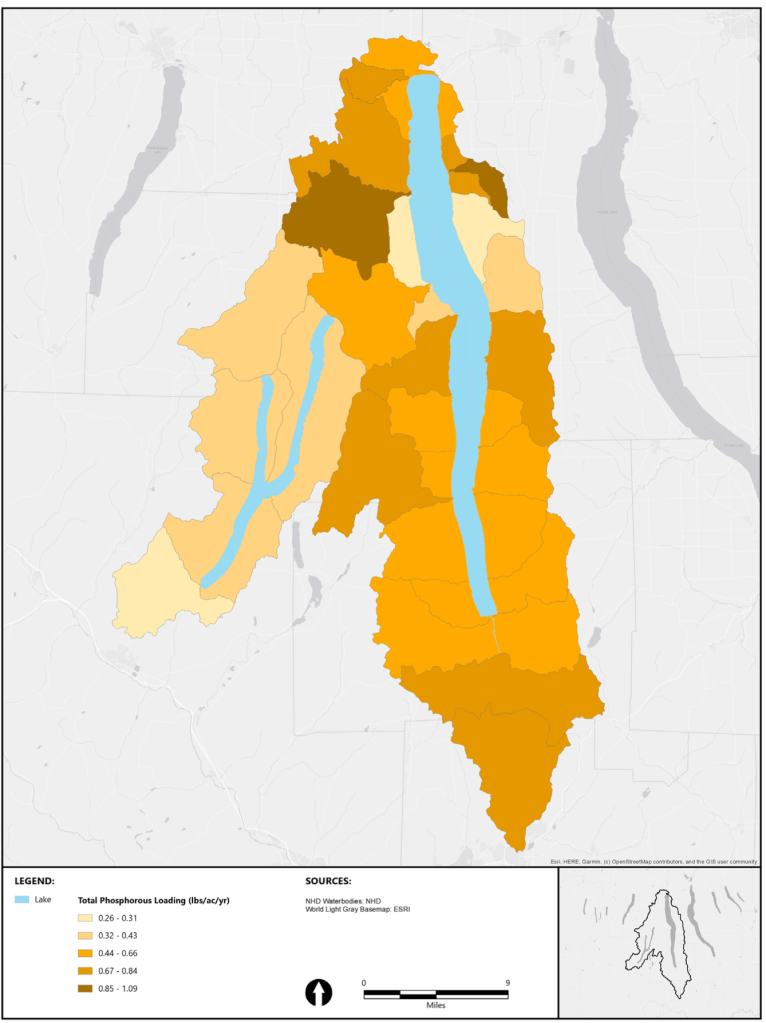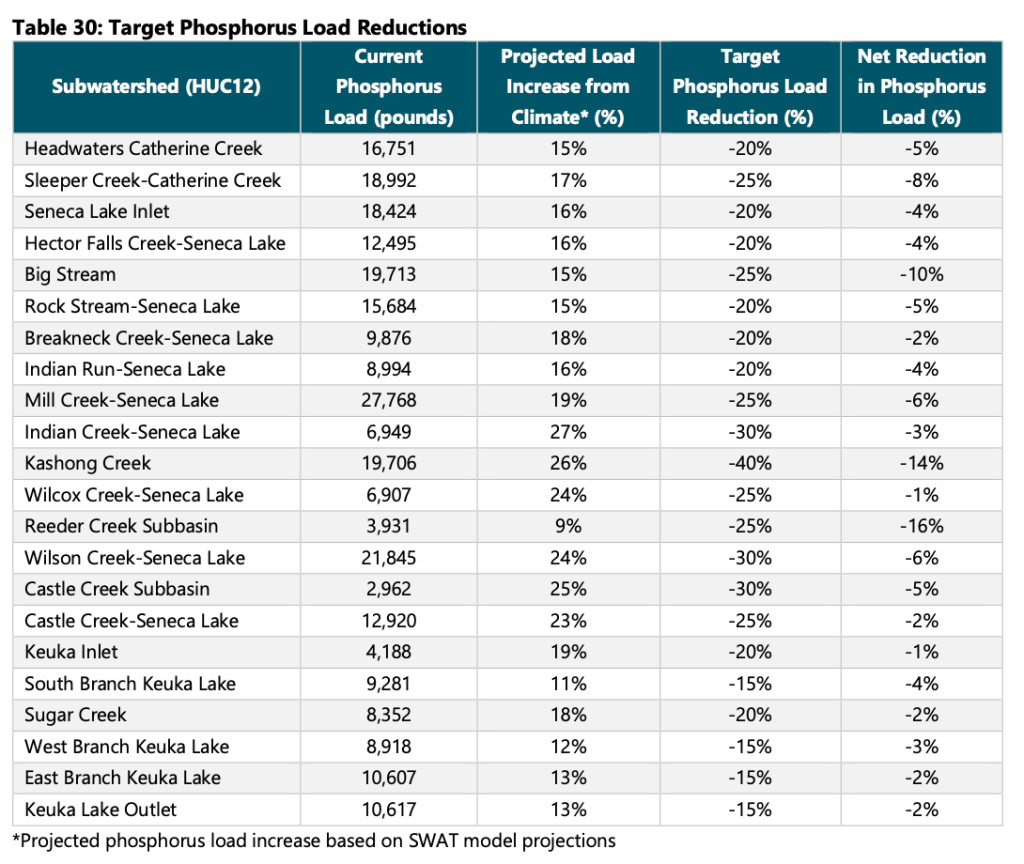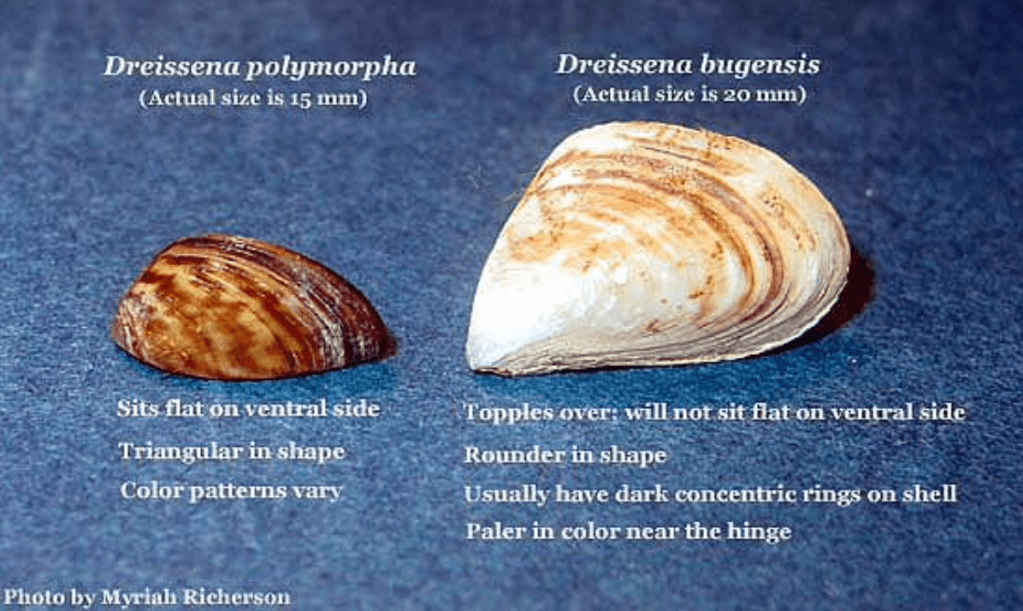GENEVA, Oct. 22, 2022 — A comprehensive plan to cut phosphorus pollution in the Seneca-Keuka Watershed won final state approval this week, providing a roadmap for protecting the two lakes from toxic algal blooms and flooding driven by climate change.

The Nine Element Plan, or 9E, was a “grass roots effort led by Finger Lakes watershed communities to actively restore these prized waters,” said Basil Seggos, commissioner of the State Department of Environmental Conservation. The DEC and the Department of State jointly approved the project.
Phosphorus is identified as a “primary driver” of outbreaks of cyanobacteria, or harmful algal blooms (HABs), that have plagued the lakes for at least the past seven years.
Polluted runoff from increasingly intense storms and waters warmed by climate change exacerbate phosphorus’ negative effects, according to the 326-page document.
Like similar studies carried out for Cayuga, Owasco and Honeoye lakes, the Seneca-Keuka 9E plan found that most phosphorus reaches the lakes through runoff from farmland.
More than 70 percent of the watershed’s phosphorus load is traceable to land dedicated to cultivated crops or hay/pasture. Those farmlands make up about 46 percent of the watershed’s acreage.

By contrast, forest lands, wetlands and scrub vegetation, which together cover 45 percent of the watershed’s acreage, produce only about 10 percent of its phosphorus.
Waste water treatment plants and other entities with state water discharge permits generate another 11 percent. Viticulture (the wine industry) produces less than 2 percent, while septic systems produce less than 1 percent.
While the detailed report clearly pinpoints farming as the region’s primary phosphorus contributor, it treats the politically powerful industry delicately.
“The link between poorly managed agricultural lands and degraded water quality is well established,” the document says. “This has often made the farming community an easy target when promoting environmental remediation. However, the diffuse and omnipresent nature of phosphorus, sediment and precipitation means all lands are potential contributors to reduced water quality. Furthermore, preservation and support of a sustainable agricultural economy is of critical importance to the Seneca-Keuka watershed community.”
One of the plan’s stated goals is a commitment to reducing phosphorus transport to the waterways that is “shared and not overly burdensome to any sector of the community.”

The 9E project was a collaborative effort overseen by Mark Venuti, Town of Geneva Supervisor and chair of the Seneca Watershed Intermunicipal Organization. The project manager was Elizabeth Moran, president of Ecologic LLC in Cazenovia, who has also collaborated on phosphorus-reduction plans for other lakes.
Other key players included Seneca Lake Water Steward Ian Smith, and Anthony Prestigiacomo and Lewis McCaffrey of the DEC.
Given limits to funding corrective measures, the team recommended prioritizing subbasins that produce the highest concentrations of phosphorus, as measured by estimated pounds of phosphorus per acre per year.


That led to particular focus on the areas around Reeder Creek, a tributary flowing into the northeast section of Seneca Lake, and Kashong Creek, a tributary flowing into northwest portion of the lake.
Seneca Lake has a surface area of 66.3 square miles. Its major inflows include Catharine Creek on its southern end and Keuka Outlet on its western side — a 6.8-mile waterway that connects the two lakes.
Keuka Lake has a surface area of 18.1 square miles. It is fed by Cold Brook (Keuka Inlet) and Sugar Creek, among others.
Both lakes are classified as mesotrophic due to their “fair” water quality and a moderate level of biological activity.
The report notes significant waterfront development on both lakes, especially around Penn Yan on Keuka and Hector on Seneca, as well as wine industry development, particularly around Hector.

Farmsteads are proliferating between the two lakes, with “over 180 new farmsteads in the watershed, demonstrating the increase in Amish and Mennonite farms.”
The team concluded that phosphorus loads from farms could be reduced by planting cover crops in winter and by improving tillage and fertilization practices.
By planting winter wheat on land classified as row crops (corn or soybeans) and harvesting it in mid-April, farms could reduce the total phosphorus load of the entire watershed by an estimated 20 percent. Individual watersheds could see phosphorus cuts that exceed 40 percent.

Regardless of progress made by farmers, increased precipitation and runoff caused by climate change is likely to increase phosphorus loads by an estimated average of 18 percent over the watershed.
But land use can serve to mitigate that impact. “Wetlands provide a buffer against flooding, woodlands buffer waterbodies from runoff, and vegetation can stabilize slopes prone to erosion,” the study found.

Rising phosphorus loads have made HABs a regular late summer occurrence on all of the Finger Lakes. Blooms on Seneca and Keuka pose a threat to drinking water, and they undermine lake recreation. (See DEC’s interactive map for HABs reported in the Finger Lakes in 2022.)
“Although a scientific consensus on the cause(s) of HABs has not yet been determined, it is clear that warming waters, periods of low winds, and phosphorus availability affect the risk of cyanobacterial blooms,” the report said.
Zebra and quagga mussels are implicated as well. They thrive in high-phosphorus waters. They also “alter the phosphorus exchange at the sediment water interface and effectively increase the biological availability of phosphorus to support the growth of algae and cyanobacteria.”


Don’t you mean sewage treatment plants not water treatment plants add phoshorus? Also, the outlet at the North end of Seneca often runs into the lake in winter when canal is closed causing muddy water running into the lake for miles. I did not see that on the list of streams.
LikeLike
Yes, wastewater treatment plants are part of the phosphorus budget calculation
LikeLike
Its about time that the environmental agencies recognize that most of the issue is farm related. Years ago when lake front owners were mandated to dig up their septics every 5 years and changes to the tank size requirements costing sometimes thousands of dollars, we felt it was a case of low hanging fruit. Feeling vindicated. While I think its everyone’s responsibility to care for our lakes, I hope that future actions include how we can mitigate farm runoff.
El
LikeLike
I wonder if anyone’s thought it might be a bad idea for the Geneva Sewage Treatment Plant’s effluent to be discharged to a stream that flows to the lake? Esp. since it “processes” landfill discharges.
LikeLike
All waste streams (human and animal) should be made into soil enhancing biochar. Using pyrolysis or gasification process, the waste can become an environmentally friendly biochar product. The biochar will enhance our soil and stop the soil and nutrient losses into our waterbodies. Carbon will also be captured in the biochar. Let us begin changing the way we handle our waste streams. Biochar is an answer to our present polluting waste handling.
LikeLike
Not only can farms reduce their runoff but they can serve as net sinks of stormwater runoff. It’s interesting that farms are shown as the problem, and only with a few management changes can go to a solution. There are also depleted roadside ditches and impermeable surfaces that help the contaminates get to the water. The solutions are simple, more hedgerows, buffer areas, plant more perennials over annuals, and help farmers get paid for their ecosystem stewardship and not just for commodity crops.
LikeLike